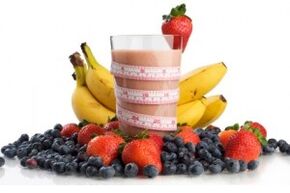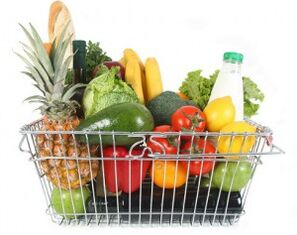The modern world is full of all sorts of food temptations. At every step we meet shops with bars, chips, breads, pies and others, which look delicious, but are sure sooner or later will lead to diseases of the stomach and digestion in general.
In ancient times, when such a disease occurred, the patient did not know about the methods of treatment and led a normal lifestyle, exacerbating his condition, which eventually led to adverse and sometimes even fatal consequences.
There are now many treatment options for gastrointestinal and gastrointestinal disorders. But for their treatment to be successful, you need to limit yourself and fully review your regular diet.
What do we call gout?

Gout is a disease that is directly related to disorders in the human body. With gout, salts from uric acid are retained in the joint tissues, which leads to very serious consequences. Gout was first mentioned during the lifetime of Hippocrates, then there were many manifestations of it.
Today, the disease is fortunately less common, with about three cases per thousand people, although outbreaks of the disease have become more frequent in recent years.
The increased percentage of morbidity with the disease is associated with the food people eat and with its amount.
Initially, an acute increase in the concentration of uric acid in a person’s blood leads to the disease. Derivatives of this concentration are carried through the body with the help of blood and stored in joints, muscles and even organs. Such sediments are dangerous because infected tissue can be destroyed. This increase in acid concentration is due to the fact that the kidneys do not have time to process and remove from the body its excess production. Also, the problem can arise as a result of kidney disease and failure.
The first symptoms of the disease are joint pain, redness of the big toe, and fever. It should be noted one very important thing that if you do not go to the doctor at the first symptom and delay the disease, the affected joint will be completely destroyed, and this will involve disability, and if the organ is destroyed, then the pain persists. and death is possible. That is why it is necessary to take this disease as seriously as possible.
The manifestation of gout directly depends on how and what a person eats and how he lives. It is not without reason that gout was previously called "the disease of kings", because an inactive lifestyle, constant consumption of fatty foods, weight, excessive consumption of alcoholic beverages together cause metabolic problems, and consequently, similar diseases. Therefore, in the treatment of gout, strict adherence to diet and appropriate diet to reduce acid production is considered very important and also the main thing. To find out the level of uric acid in the blood, you just need to donate blood for analysis.
How to eat properly?

The specificity of developing a diet for gout patients is aimed at restoring the metabolism of uric acid in the body. If you do not take immediate steps to restore this level, then the excess acid (urate sodium) is debugged throughout the body, causing widespread inflammation.
In addition to prescribing the necessary diet, doctors advise to undergo treatment with medications, as well as continuously engage in physiotherapy procedures, in addition, a person with gout is advised to lead a more active lifestyle, walk, and exercise in the fresh air.
Speaking of diet, it should be noted that the necessary step is the exclusion of some contraindicated foods from the diet. When the disease worsens, you should not eat fish and meat, it is important to arrange a fasting day at least twice a week, and ideally every day.
Fasting days for gout patients are:
- Fruits and vegetables. You need to eat one and a half kilograms of fruit per day, which is allowed by the diet.
- Milk and kefir. In this case, the patient must drink up to two liters of this fluid daily.
- Buttermilk and kefir. It needs to eat four hundred grams of cottage cheese and drink half a liter of kefir.
Such a fasting day is useful because it contributes to the dissolution of uric acid in the body and its elimination. When the severity of the disease decreases, patients can continue to eat fish and meat, but strictly steamed, boiled or roasted. Keep in mind that you should eat this product a maximum of three times a week, and not more often.
It is necessary to adhere to a proper water regime. You need to drink about three liters of clean water a day. You should drink it an hour before meals during exacerbation of the disease. If there is no deterioration, then the water can be replaced with another liquid, the main thing is that it is natural and fresh. You can also drink alkaline mineral water.
Fasting is contraindicated in gout, in this case the acid level will rise sharply, it is better to eat little, but often.
Recommended menu for gout
With gout, you need to eat natural and healthy foods. From these products, you can create a menu for each day, but you should consult with your doctor about their dosage, because the diet for everyone can be individual.
List of acceptable products:
- Meat products: turkey, rabbit, chicken; egg.
- Skinny fish; seafood: squid, shrimp.
- Cereals: whole wheat, oatmeal, millet, rice, buckwheat.
- Pasta; black and white bread.
- Vegetables: white cabbage, zucchini, eggplant, cucumbers, beets, potatoes, carrots.
- Onions, garlic, dill.
- Fruits: citrus fruits, apples, pears, apricots, melons and watermelons, peaches.
- Berries: everything is possible, except grapes and raspberries; dried fruits other than raisins; nuts.
- Sweet: not chocolate, candy, marmalade, jam, marshmallows, honey.
- Natural drinks: juices, fruit drinks, fruit drinks, kvass, an hour with lemon, rosehip or bran soup.
- First course without soup, olive oil; the second dish is a boiled or steamed product.

You can eat other foods, but in small quantities, such as boiled sausages, bacon, sausages. You can eat tomatoes and plums about twice a day and about twice a week.
Salt should be completely eliminated or its use should be significantly restricted. It is better to cook food completely without salt and add a little salt to the dishes that have been prepared on the table. Of course, oranges, oranges and most spices should be removed from the diet.
It is recommended to reduce the consumption of protein foods (especially red meat), because the accelerated protein metabolism leads to an increase in the concentration of veins. If you are overweight, you should also limit carbohydrate foods (especially baked goods, pastries).
Honey and figs, plums, grapes, some types of vegetables and root crops (turnips, celery, rhubarb, cauliflower, peppers), as well as mushrooms should be included in your diet only during remission.
Otherwise, it is necessary to consult a doctor, who will prescribe a more detailed diet for a particular stage of the disease.





















